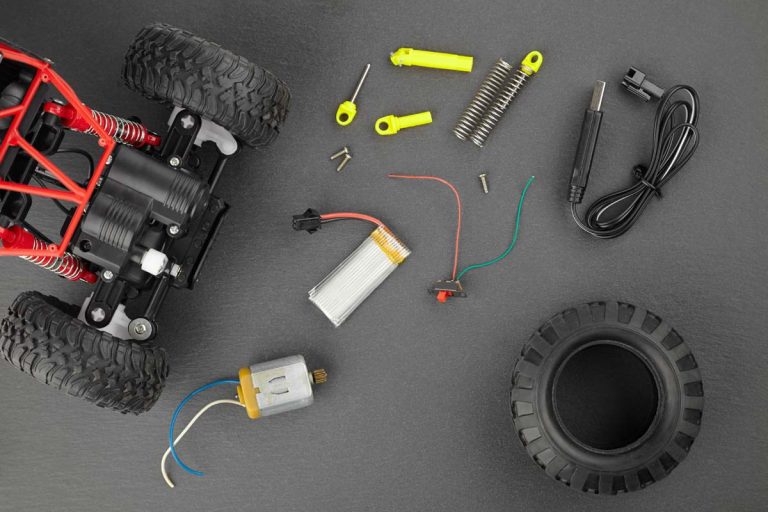រថយន្តដើរដោយសារធាតុគីមី
 Photo: © iStock fotos-v
Photo: © iStock fotos-v - Resource Type
- Project
- Subjects
- Chemistry Mathematics Physics
- Topics
- Climate Change Engineering Process Sustainability
- Time for activity
- 3 ម៉ោង
នៅក្នុងសកម្មភាពនេះសិស្សនឹងចេញមកជាមួយនឹងការរចនាច្នៃប្រឌិតថ្មី និងបង្កើតឡានក្មេងលេងដែលនឹងធ្វើជាកុងតឺន័រសម្រាប់ប្រតិកម្មគីមី។
- Introduction
-
ប្រតិកម្មគីមីគឺជាដំណើរការមួយដែលសារធាតុមួយ ឬច្រើន ត្រូវបានផ្លាស់ប្តូរបម្លែងទៅជាសារធាតុថ្មីមួយ រឺច្រើនទៀត។ មានប្រតិកម្មគីមីជាច្រើនផ្សេងៗគ្នា។ ប្រភេទសំខាន់ៗគឺការរួមបញ្ចូលគ្នា ឬប្រតិកម្មសំយោគ ប្រតិកម្មរលួយ ប្រតិកម្មផ្លាស់នៅតែមួយ ប្រតិកម្មផ្លាស់ទីទ្វេដង និងប្រតិកម្មចំហេះ។ យើងអាចរកឃើញប្រតិកម្មទាំងនេះនៅក្នុងជីវិតប្រចាំថ្ងៃ។ ដើម្បីយល់ពីប្រតិកម្មគីមីផ្សេងៗគ្នាយើងអនុវត្ត ស្ទីស្យូមេទ្រី។ ស្ទីស្យូមេទ្រីគឺជាការសិក្សាបរិមាណនៃរ៉េអាក់ទ័រ និងផលិតផលនៅក្នុងប្រតិកម្មគីមី។ ការសិក្សាអំពីបរិមាណនេះនឹងជួយឱ្យយើងដឹងថាតើត្រូវការរ៉េអាក់ទ័រប៉ុន្មាន ឬផលិតផលដែលចង់បានប៉ុន្មាននឹងត្រូវផលិត ។
នៅក្នុងសកម្មភាពនេះ សិស្សនឹងបង្កើតគំនិតច្នៃប្រឌិត និងបង្កើតឡានក្មេងលេងដែលផ្ទុកប្រតិកម្មគីមី។ ដូចគ្នានេះដែរសិស្សនឹងប្រើប្រតិកម្មរវាងសូដាដុតនំ (សូដ្យូមប៊ីកាកាបូណាត) និងទឹកខ្មះ (អាស៊ីតអាសេទិកដែលរលាយ) ដើម្បីផ្តល់ថាមពលដល់ឡានក្មេងលេងហើយរំកិលវាក្នុងចំងាយជាក់លាក់ដែលកំណត់ដោយគ្រូ។ សិស្សនឹងធ្វើការសាកល្បងចំនួន 3ដង ដោយប្រើបរិមាណសូដាខុសៗគ្នា និងកំណត់ថាតើចំនួនមួយណាដែលសមនឹងប្រតិកម្មបំផុត។
សកម្មភាពនេះនឹងលើកទឹកចិត្តសិស្សឱ្យមានភាពច្នៃប្រឌិត។ វាក៏នឹងបណ្តុះបណ្តាលជំនាញនៃការត្រិះរិះពិចារណារបស់សិស្សក្នុងការវាយតម្លៃពីរបៀបនិង ហេតុផលដែលអាចអោយឡានលេងផ្លាស់ទី។ នៅពេលអនាគតសិស្សអាចមានលទ្ធភាពបង្កើតប្រតិកម្មគីមីដែលអាចត្រូវបានប្រើជាឥន្ធនៈដើម្បីផ្តល់ថាមពលដល់រថយន្តដែលមានតំលៃសមរម្យ និងអាចជឿទុកចិត្តបានដោយមិនមានគ្រោះថ្នាក់។
- Key Objectives
-
- រចនានិងផលិតឡានជ័រដែលប្រើសម្រាប់ផ្ទុកប្រតិកម្ម។
- ប្រើប្រាស់ប្រតិកម្មគីមីក្នុងការផ្តល់ថាមពលដល់ឡាន
- សរសេរតុល្យភាពសមីការគីមី សម្រាប់ប្រតិកម្ម
- គណនាបរិមាណសូដាដុតនំដែលនឹងផ្តល់នូវប្រតិកម្មពេញលេញ។ ប្រឆាំងនឹងបរិមាណទឹកខ្មះដែលនឹងដាក់ឱ្យ។
- Guiding Questions
-
- តើអ្នករចនាឡានរបស់អ្នកយ៉ាងដូចម្តេច?
- តើសមា្ភរៈអ្វីខ្លះដែលអ្នកប្រើជាកង់? ហេតុអ្វី?
- តើប្រតិកម្មគីមីណាមួយពាក់ព័ន្ធនឹងការផ្តល់ថាមពលដល់រថយន្តរបស់អ្នក?
- តើការរចនានៃឡានរបស់អ្នកមានឥទ្ធិពលយ៉ាងណាទៅលើចលនារបស់ឡាន?
- តើឡានអាចធ្វើំណើរក្នុងរយៈចម្ងាយប៉ុន្មាន?
- តើប្រតិកម្មមានរយៈពេលប៉ុន្មានក្នុងការសាកល្បងនីមួយៗ?

/rating_off.png)



